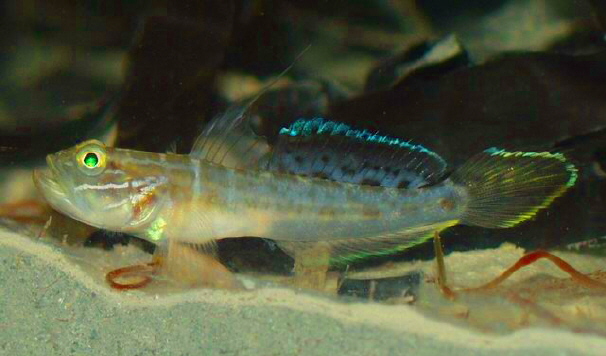Goby (Family: Gobiidae) - Wiki Goby
From Wikipedia, the free encyclopedia
[Photo] Microgobius gulosus. Clown goby (Microgobius gulosus) from the USGS http://cars.er.usgs.gov/pics/goby/goby/goby_15.html
The gobies form the family Gobiidae, which is one of the largest families of fish, with more than 2,000 species in more than 200 genera. Most are relatively small, typically less than 10 cm (4 in) in length. Gobies include some of the smallest vertebrates in the world, like species of the genera Trimmaton and Pandaka, which are under 1 cm (3/8 in) long when fully grown. There are some large gobies, such as some species of the genera Gobioides or Periophthalmodon, that can reach over 30 cm (1 ft) in length, but that is exceptional. Although few are important as food for humans, they are of great significance as prey species for commercially important fish like cod, haddock, sea bass, and flatfish. Several gobies are also of interest as aquarium fish, such as the bumblebee gobies of the genus Brachygobius.
The most distinctive aspect of goby morphology are the fused pelvic fins that form a disc-shaped sucker. This sucker is functionally analogous to the dorsal fin sucker possessed by the remoras or the pelvic fin sucker of the lumpsuckers, but is anatomically distinct: these similarities are the product of convergent evolution. Gobies can often be seen using the sucker to adhere to rocks and corals, and in aquaria they will happily stick to glass walls of the tank as well.
Gobies are primarily fish of shallow marine habitats including tide pools, coral reefs, and seagrass meadows; they are also very numerous in brackish water and estuarine habitats including the lower reaches of rivers, mangrove swamps, and salt marshes. A small number of gobies (unknown exactly, but in the low hundreds) are also fully adapted to freshwater environments. These include the Asian river gobies (Rhinogobius spp.), the Australian desert goby (Chlamydogobius eremius), and the European freshwater goby Padogobius bonelli.
Mudskippers
Mudskippers are highly specialised members of the family, usually ascribed to the subfamily Oxudercinae. They are able to survive for extended periods on land through a combination of behavioural and physiological adaptations, including pectoral fins that act as simple legs; the ability to breathe through their skins (like frogs); and the digging of damp burrows to avoid drying out. Mudskippers live in tidal areas, particular on mudflats and in mangrove forests, and are only found in tropical and subtropical regions.
Symbiosis
Gobies sometimes form symbiotic relationships with other species. Some goby species live in symbiosis with burrowing shrimps. The shrimp maintains a burrow in the sand in which both the shrimp and the goby fish live. The shrimp has poor eyesight compared to the goby, but if it sees or feels the goby suddenly swim into the burrow, it will follow. The goby and shrimp keep in contact with each other, the shrimp using its antennae, and the goby flicking the shrimp with its tail when alarmed. These gobies are thus sometimes known as watchman gobies. Each party gains from this relationship: the shrimp gets a warning of approaching danger, and the goby gets a safe home and a place to lay its eggs.
Another example of symbiosis is demonstrated by the neon gobies (Gobiosoma spp.). These gobies are known as "cleaner gobies", and remove parasites from the skin, fins, mouth, and gills of a wide variety of large fish. The most remarkable aspect of this symbiosis is that many of the fish that visit the cleaner gobies' cleaning station would otherwise treat such small fish as food (for example groupers and snappers). Again, this is a relationship where both parties gain: the gobies get a continual supply of food as big fish visit their cleaning stations, and the big fish leave the cleaning station healthier than they were when they arrived.
In aquaria
Several species of goby are kept in aquaria. The bumblebee gobies, genus Brachygobius are perhaps the most widely traded examples, being small, colourful, and easy to care for. They need tropical, hard and alkaline freshwater or slightly brackish conditions to do well. Gobies are generally peaceful towards their tankmates though territorial among themselves. Since most are small and few are predatory towards other fishes, they usually make good community fishes. Typically, the main problem with gobies is feeding them: with a few exceptions, the small species kept in aquaria prefer live or frozen foods rather than flake, and they are not very good at competing with active species such as cichlids. It is often recommended that gobies be kept on their own or with peaceful surface dwelling species such as halfbeaks and guppies.
http://en.wikipedia.org/wiki/Goby
| The text in this page is based on the copyrighted Wikipedia article shown in above URL. It is used under the GNU Free Documentation License. You may redistribute it, verbatim or modified, providing that you comply with the terms of the GFDL. |
